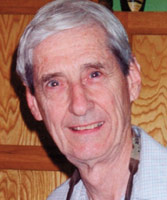
The NABS Stereo Gallery
Instructions | About the photos | First arch in Gallery | Stereo Arch Index
The Natural Arch and Bridge Society is proud to present this collection of stereo photographs of natural arches. The purpose of this Gallery is to both share and preserve this unique and remarkable collection. There are 88 arches in this Gallery.
INSTRUCTIONS
There are four ways to view these photos. Each page has two sets of photos. The top one is a set of parallel photos. The bottom one is a set of crossed photos. This is explained below.
1. You may view the photos in regular mono mode (no 3D effect). Each photo is 350 pixels wide, large enough for a very good presentation. The arch photos are very good in mono mode, and constitute a nice Gallery even without the 3D effect.
2. You may obtain a Loreo Lite 3D Viewer for $3.90 from the loreo.com order page. These viewers will allow you to easily view the top set of parallel images on your computer screen in 3D. This is probably the best bet for most people. When you use the viewer you are using distance vision, so if you wear glasses for distance vision, use your glasses. If you wear bifocals, use the distance area of the bifocals. Most people will need to back away from the screen a bit. Relax your eyes and experiment with distance to get a proper 3D image. You will actually see three images. The center one will be 3D. Ignore the other two peripheral images.
3. The bottom set of crossed images can be viewed in 3D by using the cross-eyed method described here. The images are reversed right to left in the crossed set of images. Not everyone can accomplish the use of this method, and it can cause some eye strain. If this doesn't work for you, you can always resort to methods 1 or 2 above.
4. The top set of parallel images can (with difficulty) be viewed in 3D by using the parallel viewing method described here. Not everyone can accomplish this, and it can cause some eye strain. This is especially true in this case because this method is normally used with much smaller images. However, majestic natural arches just cannot be displayed properly using such small images. You will likely need to back far away from the screen and/or view the images on a high resolution screen (which makes them smaller). Once again, you can always resort to methods 1 or 2 above.
5. No matter how you view them — enjoy!
ABOUT THE PHOTOS AND PHOTOGRAPHERS
Copyright retained by the photographers.

The late QUENTIN BURKE, a stereographer from Holtville, CA, and a charter member of NABS, took the majority of these photos. Most of them were taken on NABS outings.
The photographs were taken using a 1950s era Kodak 35mm stereo camera, with manual shutter, focus, and aperture settings. Film used was mostly Kodak Gold 100 ASA color negative film. Exposures were judged from experience, or with a light meter, which in the sunny canyon country of Utah and Arizona means 1/100 of a second, with aperture midway between f11 and f16.
The camera has two lenses, one taking a picture of the scene as viewed by the taker's left eye, and the other the right eye. Although the pairs of pictures may appear to be identical, careful examination will reveal that they are not. When viewing the images, either with a viewer in the parallel mode, or cross-eyed with the crossed images, the brain puts the two pictures together and yields a three-dimensional image.
While a regular 35 mm camera takes a picture "7 perfs" wide (perforations) the stereo camera produces images that are "5 perfs" wide. Some one-hour processors can handle stereo prints from this size negative, but most stereo photographers prefer to deal with processors who specialize in processing stereo prints.
ALAN SILVERSTEIN
is a software engineer who writes:
"These photos were taken with a Pentax ME Super SLR camera on ISO 200, 35mm print film, and almost always with a 50 mm lens (but a 200 mm telephoto in the case of Rim Arches). To take a stereo pair, I set the speed, f-stop, and focus, figure out my shots, and then take them in quick succession as rapidly as I can, before clouds move, etc. I pay attention to the framing of the first image, then note where the center of the image points. After shooting the first picture I walk as perpendicularly as possible to the line of sight, aim at the same center point (and with the same alignment to level), and shoot the second photo.
"How far do you move? It depends, and this is where some practice helps. I look at a near/far edge in the image and I move until the background seems to have shifted just the right amount at that edge. It's done very much by feel. Through trial and error I've learned to avoid, if possible, close foregrounds that will shift too much (hyperstereo) or even be radically different in the two images; and also to avoid people unless they hold still, etc. For close-up scenes or when constrained by the terrain, I don't move very much, just a few feet. For distant scenes, such as the Goosenecks of the San Juan, I've learned I must move 100 feet or more. The key is to notice the foreground/background shifts and make them about right.
"I'm now learning to take stereo pairs with a digital camera. I need to be sure to turn off AWB (automatic white balance) so the two images have about the same color balance."
Go to first arch in the Stereo Gallery | Go to Stereo Arch Index